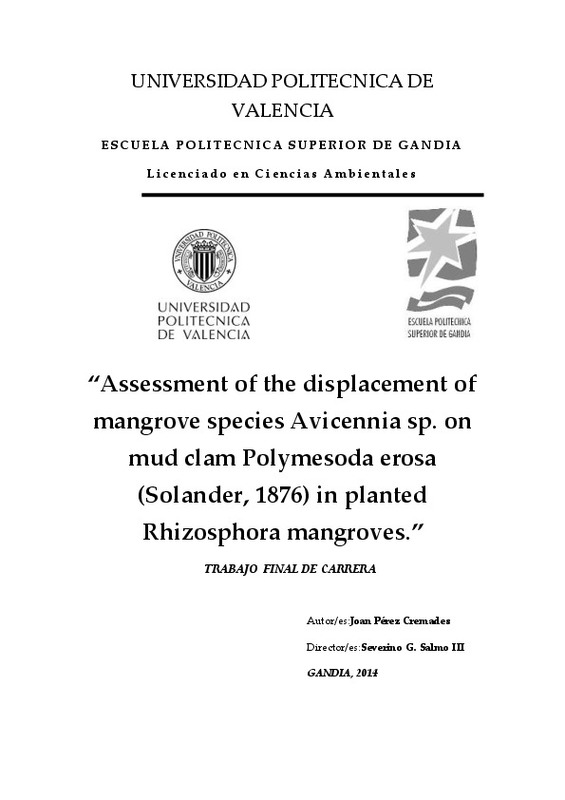JavaScript is disabled for your browser. Some features of this site may not work without it.
Buscar en RiuNet
Listar
Mi cuenta
Estadísticas
Ayuda RiuNet
Admin. UPV
Assessment of the displacement of mangrove species Avicennia sp. on mud clam Polymesoda erosa (Solander, 1876) in planted Rhizosphora mangroves
Mostrar el registro sencillo del ítem
Ficheros en el ítem
| dc.contributor.advisor | González Romero, Juan Andrés
|
es_ES |
| dc.contributor.advisor | Salmo III, Severino G.
|
es_ES |
| dc.contributor.author | Pérez Cremades, Joan
|
es_ES |
| dc.date.accessioned | 2015-02-17T15:11:15Z | |
| dc.date.available | 2015-02-17T15:11:15Z | |
| dc.date.created | 2014-04-08 | |
| dc.date.issued | 2015-02-17 | |
| dc.identifier.uri | http://hdl.handle.net/10251/47217 | |
| dc.description.abstract | The mangrove ecosystem in the Philippines consists of 35-40 mangrove species. Mangroves use to grow on soft muddy substrate, commonly in estuaries where they can find sheltered and shallow coasts, and they can also grow in more salty waters on island shores and tidal flats The substrate is one of the most important aspects that determine mangrove distribution, and the macrofauna is one of the things which affect the substrate composition. In this study we will focus on the study of macro-invertebrate fauna (mollusc), and its ecological relationship with the mangrove species. We are going to study if the lack of plant biodiversity affect to the faunal biodiversity and the ecological quality of mangroves, and our hypothesis are that the monospecific reforestation of mangroves entails the loss of vegetal biodiversity, which is the ecological support of many other fauna and flora species. To find scientific data and references that endorse those statements, our main aim will be to statistically relate the distribution and abundance of plant and faunal biodiversity. In order to make that tangled task reachable we will focus on a few species. Those are the mangrove species Avicennia sp. and Rhyzophora sp. and the mud clam Polymesoda erosa (Solander, 1876) among other molluscs. | es_ES |
| dc.format.extent | 17 | es_ES |
| dc.language | Inglés | es_ES |
| dc.publisher | Universitat Politècnica de València | es_ES |
| dc.rights | Reconocimiento - No comercial - Sin obra derivada (by-nc-nd) | es_ES |
| dc.subject | Rhyzophora sp. | es_ES |
| dc.subject | Avicennia sp. | es_ES |
| dc.subject | Polymesoda erosa | es_ES |
| dc.subject | Mollucs | es_ES |
| dc.subject | Mangrove | es_ES |
| dc.subject.classification | TECNOLOGIA DEL MEDIO AMBIENTE | es_ES |
| dc.subject.other | Licenciatura en Ciencias Ambientales-Llicenciatura en Ciències Ambientals | es_ES |
| dc.title | Assessment of the displacement of mangrove species Avicennia sp. on mud clam Polymesoda erosa (Solander, 1876) in planted Rhizosphora mangroves | es_ES |
| dc.type | Proyecto/Trabajo fin de carrera/grado | es_ES |
| dc.rights.accessRights | Abierto | es_ES |
| dc.contributor.affiliation | Universitat Politècnica de València. Departamento de Ingeniería Hidráulica y Medio Ambiente - Departament d'Enginyeria Hidràulica i Medi Ambient | es_ES |
| dc.contributor.affiliation | Universitat Politècnica de València. Escuela Politécnica Superior de Gandia - Escola Politècnica Superior de Gandia | es_ES |
| dc.contributor.affiliation | Universitat Politècnica de València. Instituto Universitario de Ingeniería del Agua y del Medio Ambiente - Institut Universitari d'Enginyeria de l'Aigua i Medi Ambient | es_ES |
| dc.description.bibliographicCitation | Pérez Cremades, J. (2014). Assessment of the displacement of mangrove species Avicennia sp. on mud clam Polymesoda erosa (Solander, 1876) in planted Rhizosphora mangroves. Universitat Politècnica de València. http://hdl.handle.net/10251/47217 | es_ES |
| dc.description.accrualMethod | Archivo delegado | es_ES |
Este ítem aparece en la(s) siguiente(s) colección(ones)
-
EPSG - Trabajos académicos [5004]
Escuela Politécnica Superior de Gandia






